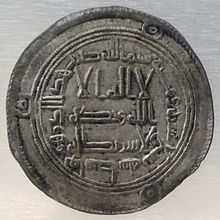Hisham ibn ´Abd al-Malik
| Hisham ibn Abd al-Malik هشام بن عبد الملك |
|||||
|---|---|---|---|---|---|

Coin by Hisham ibn Abd al-Malik
|
|||||
| Caliph of the Umayyad Caliphate | |||||
| Reign | 26 January 724 – 6 February 743 | ||||
| Predecessor | Yazid bin Abd al-Malik | ||||
| Successor | Walid ibn Yazid | ||||
| Born | 691 | ||||
| Died | 6 February 743 (aged 52) | ||||
| Issue |
Maslama Mu'awiya Sa'id Sulayman |
||||
|
|||||
| Dynasty | Umayyad, Marwanid branch | ||||
| Father | Abd al-Malik ibn Marwan | ||||
| Mother | Fatima bint Hisham | ||||
| Full name | |
|---|---|
| Hisham ibn Abd al-Malik ibn Marwan |
Hisham ibn Abd al-Malik (691 – 6 February 743) (Arabic: هشام بن عبد الملك) was the 10th Umayyad caliph who ruled from 724 until his death in 743. When he was born in 691 his mother named him after her father.
Inheriting the caliphate from his brother Yazid II, Hisham was ruling an empire with many different problems. He would, however, be effective in attending to these problems, and in allowing the Umayyad empire to continue as an entity. His long rule was an effective one, and it saw a rebirth of reforms that were originated by Umar bin Abd al-Aziz.
Like his brother al-Walid I, Hisham was a great patron of the arts, and he again encouraged arts in the empire. He also encouraged the growth of education by building more schools, and perhaps most importantly, by overseeing the translation of numerous literary and scientific masterpieces into Arabic. He returned to a stricter interpretation of the Sharia as Umar had, and enforced it, even upon his own family. His ability to stand up to the Umayyad clan may have been an important factor in his success, and may point to why his brother Yazid was ineffective.
On the military front his empire suffered a series of setbacks, especially in the Caucasus against the Khazars (the Battle of Marj Ardabil) and in Transoxiana against the Turgesh (the "Day of Thirst" and the Battle of the Pass). Hisham sent armies to end the Hindu rebellion in Sindh, and was successful when the Hindu ruler Jai Singh was killed. This allowed the Umayyads to reassert their rule over some portions of their provinces in India.
...
Wikipedia
